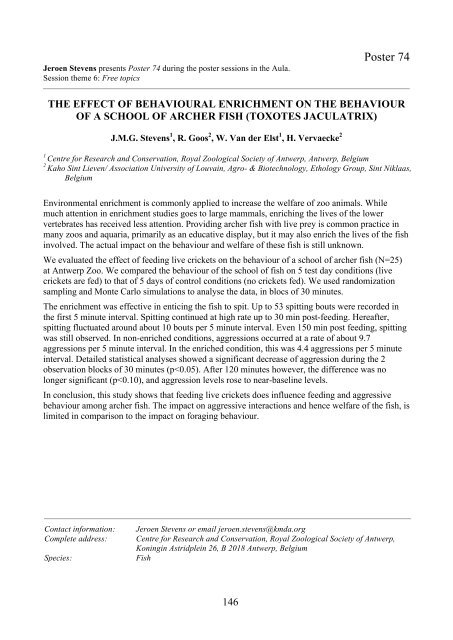Acknowledgements Book of abstracts - Publicaties - Vlaanderen.be
Acknowledgements Book of abstracts - Publicaties - Vlaanderen.be
Acknowledgements Book of abstracts - Publicaties - Vlaanderen.be
You also want an ePaper? Increase the reach of your titles
YUMPU automatically turns print PDFs into web optimized ePapers that Google loves.
Jeroen Stevens presents Poster 74 during the poster sessions in the Aula.<br />
Session theme 6: Free topics<br />
146<br />
Poster 74<br />
THE EFFECT OF BEHAVIOURAL ENRICHMENT ON THE BEHAVIOUR<br />
OF A SCHOOL OF ARCHER FISH (TOXOTES JACULATRIX)<br />
J.M.G. Stevens 1 , R. Goos 2 , W. Van der Elst 1 , H. Vervaecke 2<br />
1 Centre for Research and Conservation, Royal Zoological Society <strong>of</strong> Antwerp, Antwerp, Belgium<br />
2 Kaho Sint Lieven/ Association University <strong>of</strong> Louvain, Agro- & Biotechnology, Ethology Group, Sint Niklaas,<br />
Belgium<br />
Environmental enrichment is commonly applied to increase the welfare <strong>of</strong> zoo animals. While<br />
much attention in enrichment studies goes to large mammals, enriching the lives <strong>of</strong> the lower<br />
vertebrates has received less attention. Providing archer fish with live prey is common practice in<br />
many zoos and aquaria, primarily as an educative display, but it may also enrich the lives <strong>of</strong> the fish<br />
involved. The actual impact on the <strong>be</strong>haviour and welfare <strong>of</strong> these fish is still unknown.<br />
We evaluated the effect <strong>of</strong> feeding live crickets on the <strong>be</strong>haviour <strong>of</strong> a school <strong>of</strong> archer fish (N=25)<br />
at Antwerp Zoo. We compared the <strong>be</strong>haviour <strong>of</strong> the school <strong>of</strong> fish on 5 test day conditions (live<br />
crickets are fed) to that <strong>of</strong> 5 days <strong>of</strong> control conditions (no crickets fed). We used randomization<br />
sampling and Monte Carlo simulations to analyse the data, in blocs <strong>of</strong> 30 minutes.<br />
The enrichment was effective in enticing the fish to spit. Up to 53 spitting bouts were recorded in<br />
the first 5 minute interval. Spitting continued at high rate up to 30 min post-feeding. Hereafter,<br />
spitting fluctuated around about 10 bouts per 5 minute interval. Even 150 min post feeding, spitting<br />
was still observed. In non-enriched conditions, aggressions occurred at a rate <strong>of</strong> about 9.7<br />
aggressions per 5 minute interval. In the enriched condition, this was 4.4 aggressions per 5 minute<br />
interval. Detailed statistical analyses showed a significant decrease <strong>of</strong> aggression during the 2<br />
observation blocks <strong>of</strong> 30 minutes (p
















